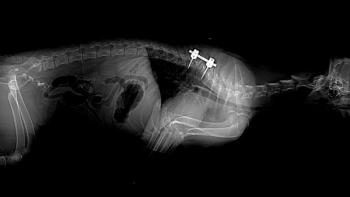
Traumatic brain injury (Proceedings)
Traumatic brain injury.
• Primary brain injury
o Direct parenchymal and vascular damage
o Occurs immediately as a result of traumatic event
• Secondary brain injury
o Result of biochemical cascades initiated by primary injury
o Includes ATP depletion, increases in intracellular Na+ and Ca2+ as well as extracellular excitatory neurotransmitters, production of oxygen free radicals, increased cytokine production, accumulation of nitric oxide, lactic acidosis and activation of arachidonic acid, kinin, complement, coagulation and fibrinolytic cascades
o Results in further damage to brain tissue and resultant increases in intracranial pressure (ICP)
o Therapy directed at minimizing secondary injury
• Intracranial pressure dynamics
o ICP = pressure exerted by tissues and fluid within the skull
o Cerebral blood flow determined in large part by cerebral perfusion pressure (CPP) CPP = MAP– ICP (where MAP = mean arterial blood pressure)
o Autoregulatory mechanisms used to maintain ICP within normal limits despite normal fluctuations in MAP, via vasoconstriction and vasodilation
o As intracranial volume increases (e.g. from hemorrhage, edema), compensatory mechanisms shift fluid (blood, CSF) to maintain ICP constant; progressive increases beyond this capacity result in increases in ICP with subsequent decreases in CPP and ischemic injury to the brain
• Therapeutic goals
o Preservation of CPP by:
• Controlling ICP
• Maintaining adequate MAP
• Decreasing cerebral metabolism
o Maintenance of oxygen availability
• Extracranial assessment and therapy
o Airways, Breathing & Circulation (ABCs) 1st
• Airway obstruction should be addressed ASAP – even mild hypercapnia can have a significant effect on ICP
• Oxygen supplementation should be provided
• Hypovolemic shock should be treated aggressively with goal of MAP 80-100 (but no more than 120mmHg)
• Hypovolemia and hypoxemia are strongly correlated with elevated ICP and increased mortality in humans with TBI
o Often concurrent extracranial trauma
• Pneumothorax, pulmonary contusions
• Traumatic cardiac arrhythmias
• Fractures (other than skull)
o Laboratory tests of particular importance include PCV/TP, electrolytes, blood gas analysis
• Intracranial assessment and therapy
o Important components of neurologic exam
• Mentation – obtunded, stuporous, comatose, ± compulsive
• Motor/Posture – ambulatory, recumbent, muscle tone and movements
• Brainstem function – pupil size/symmetry, PLRs, physiologic nystagmus
o Modified Glasgow Coma Scale in dogs based on findings above – shown to be related to survival at 48h
o Initial neurologic status may improve following initial therapy for shock; reassess neurologic status often, as changes can occur rapidly
o ICP monitoring ideal for dictating therapy; indirect assessment via trends in patient's neurologic exam used more often (and less accurately) in veterinary settings
o Diagnostic imaging
• Skull radiographs – depressed skull fractures may be seen, inadequate for more thorough evaluation of injuries
• CT preferred in acute evaluation vs. MRI
o Hyperosmotics
• Mannitol – osmotic diuretic
• Decreases brain edema and ICP in TBI via several mechanisms
• 0.5-1.0g/kg IV bolus dosing more effective than CRI
• Effects last 2-5h
• Important to monitor serum osmolality and electrolytes with repeated use
• Hypertonic saline
• Similar osmotic effects to mannitol
• Additional benefit of improved hemodynamic status – good choice for TBI in hypovolemic patients
o Corticosteroids
• A randomized placebo controlled study of over 10,000 human TBIpatients showed treatment with methylprednisolone resulted in a significantly increased risk of death in the steroid group vs. controls.
• Not recommended for TBI patients
o Furosemide
• Not recommended specifically for TBI given IV volume depletion and risk of systemic hypotension
o Decreasing cerebral blood volume (and therefore ICP)
• Elevation of the head by 15-30° used to increase venous drainage (avoid jugular vein compression!)
• Maintenance of normocapnia ideal; short term hyperventilation can be used to decrease ICP in the quickly deteriorating patient, but can ultimately result in decreases in cerebral blood flow
o Anticonvulsants
Indicated in face of TBI induced seizures
• Potential role of preventing seizures in first 7 days in humans
o Analgesics
• To be considered, especially in face of concurrent injuries
• Can potentially interfere with neurologic assessment, however
o Polyethylene glycol (PEG)
• Hydrophilic polymer shown to have reparative effects with in vitro models of CNS injury
• Potential future role in treatment of TBI
o Surgical intervention
• Craniectomy should be considered in open or depressed skull fractures, identification of focal intracranial hematoma or in the face of progressive neurologic deterioration despite aggressive medical management
o Moderate hypothermia
• Investigated in human medicine as a means of decreasing ICP and improving outcome; results have been variable and so not recommended
• Prognosis and complications
o Prognosis generally considered guarded to poor, but even severe cases can show marked improvement over the first few days after injury
• Loss of brainstem reflexes poor prognostic indicator
o Persistent neurologic deficits and/or seizures are common
o Additional complications include aspiration pneumonia, coagulopathies, fluid and electrolyte imbalances, sepsis, meningitis, CSF leakage as well as those seen with recumbent patients – e.g. UTI, pressure sores
Suggested reading:
Emergency Management of the Head trauma Patient, Dewey, CW, The Veterinary Clinics of North America: Small Animal Practice, Common Neurologic Problems, 30(1), 2000
Final results of MRC CRASH, a randomised placebo-controlled trial of intravenous corticosteroid in adults with head injury-outcomes at 6 months. Edwards P, et al. Lancet, 2005 Jun 4-10:365(9475):1957-9.
Newsletter
From exam room tips to practice management insights, get trusted veterinary news delivered straight to your inbox—subscribe to dvm360.




